Publications
Publications in peer reviewed journals
Impaired Mucosal Homeostasis in Short-Term Fiber Deprivation Is Due to Reduced Mucus Production Rather Than Overgrowth of Mucus-Degrading Bacteria.
2022 - Nutrients, 14: 3802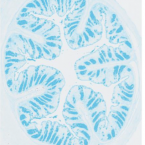
Abstract:
The gut mucosal environment is key in host health; protecting against pathogens and providing a niche for beneficial bacteria, thereby facilitating a mutualistic balance between host and microbiome. Lack of dietary fiber results in erosion of the mucosal layer, suggested to be a result of increased mucus-degrading gut bacteria. This study aimed to use quantitative analyses to investigate the diet-induced imbalance of mucosal homeostasis. Seven days of fiber-deficiency affected intestinal anatomy and physiology, seen by reduced intestinal length and loss of the colonic crypt-structure. Moreover, the mucus layer was diminished, expression decreased, and impaired mucus secretion was detected by stable isotope probing. Quantitative microbiome profiling of the gut microbiota showed a diet-induced reduction in bacterial load and decreased diversity across the intestinal tract, including taxa with fiber-degrading and butyrate-producing capabilities. Most importantly, there was little change in the absolute abundance of known mucus-degrading bacteria, although, due to the general loss of taxa, relative abundance would erroneously indicate an increase in mucus degraders. These findings underscore the importance of using quantitative methods in microbiome research, suggesting erosion of the mucus layer during fiber deprivation is due to diminished mucus production rather than overgrowth of mucus degraders.
A look beyond dietary (poly)phenols: The low molecular weight phenolic metabolites and their concentrations in human circulation.
2022 - Compr Rev Food Sci Food Saf, 5: 3931-3962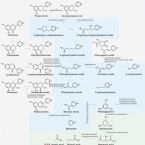
Abstract:
A large number of epidemiological studies have shown that consumption of fruits, vegetables, and beverages rich in (poly)phenols promote numerous health benefits from cardiovascular to neurological diseases. Evidence on (poly)phenols has been applied mainly to flavonoids, yet the role of phenolic acids has been largely overlooked. Such phenolics present in food combine with those resulting from gut microbiota catabolism of flavonoids and chlorogenic acids and those produced by endogenous pathways, resulting in large concentrations of low molecular weight phenolic metabolites in human circulation. Independently of the origin, in human intervention studies using diets rich in (poly)phenols, a total of 137 low molecular weight phenolic metabolites have been detected and quantified in human circulation with largely unknown biological function. In this review, we will pinpoint two main aspects of the low molecular weight phenolic metabolites: (i) the microbiota responsible for their generation, and (ii) the analysis (quali- and quantitative) in human circulation and their respective pharmacokinetics. In doing so, we aim to drive scientific advances regarding the ubiquitous roles of low molecular weight phenolic metabolites using physiologically relevant concentrations and under (patho)physiologically relevant conditions in humans.
Single-cell stable isotope probing in microbial ecology
2022 - ISME Commun, 2: 55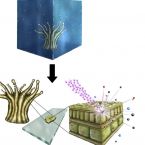
Abstract:
Environmental and host-associated microbiomes are typically diverse assemblages of organisms performing myriad activities and engaging in a network of interactions that play out in spatially structured contexts. As the sum of these activities and interactions give rise to overall microbiome function, with important consequences for environmental processes and human health, elucidating specific microbial activities within complex communities is a pressing challenge. Single-cell stable isotope probing (SC-SIP) encompasses multiple techniques that typically utilize Raman microspectroscopy or nanoscale secondary ion mass spectrometry (NanoSIMS) to enable spatially resolved tracking of isotope tracers in cells, cellular components, and metabolites. SC-SIP techniques are uniquely suited for illuminating single-cell activities in microbial communities and for testing hypotheses about cellular functions generated for example from meta-omics datasets. Here, we illustrate the insights enabled by SC-SIP techniques by reviewing selected applications in microbiology and offer a perspective on their potential for future research.
Early-life chemical exposome and gut microbiome development: African research perspectives within a global environmental health context.
2022 - Trends Microbiol, 11: 1084-1100
Abstract:
The gut microbiome of neonates, infants, and toddlers (NITs) is very dynamic, and only begins to stabilize towards the third year of life. Within this period, exposure to xenobiotics may perturb the gut environment, thereby driving or contributing to microbial dysbiosis, which may negatively impact health into adulthood. Despite exposure of NITs globally, but especially in Africa, to copious amounts and types of xenobiotics - such as mycotoxins, pesticide residues, and heavy metals - little is known about their influence on the early-life microbiome or their effects on acute or long-term health. Within the African context, the influence of fermented foods, herbal mixtures, and the delivery environment on the early-life microbiome are often neglected, despite being potentially important factors that influence the microbiome. Consequently, data on in-depth understanding of the microbiome-exposome interactions is lacking in African cohorts. Collecting and evaluating such data is important because exposome-induced gut dysbiosis could potentially favor disease progression.
Next-generation biomonitoring of the early-life chemical exposome in neonatal and infant development.
2022 - Nat Commun, 1: 2653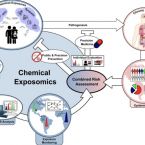
Abstract:
Exposure to synthetic and natural chemicals is a major environmental risk factor in the etiology of many chronic diseases. Investigating complex co-exposures is necessary for a holistic assessment in exposome-wide association studies. In this work, a sensitive liquid chromatography-tandem mass spectrometry approach was developed and validated. The assay enables the analysis of more than 80 highly-diverse xenobiotics in urine, serum/plasma, and breast milk; with detection limits generally in the pg-ng mL range. In plasma of extremely-premature infants, 27 xenobiotics are identified; including contamination with plasticizers, perfluorinated alkylated substances and parabens. In breast milk samples collected longitudinally over the first 211 days post-partum, 29 analytes are detected, including pyrrolizidine- and tropane alkaloids which have not been identified in this matrix before. A preliminary estimation of daily toxicant intake via breast milk is conducted. In conclusion, we observe significant early-life co-exposure to multiple toxicants, and demonstrate the method's applicability for large-scale exposomics-type cohort studies.
Specific localization and quantification of the Oligo-Mouse-Microbiota (OMM12) by fluorescence in situ hybridization (FISH)
2022 - Current Protocols, 2: e548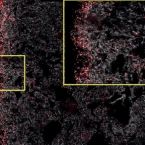
Abstract:
The oligo-mouse-microbiota (OMM12) is a widely used syncom that colonizes gnotobiotic mice in a stable manner. It provides several fundamental functions to its murine host, including colonization resistance against enteric pathogens. Here, we designed and validated specific fluorescence in situ hybridization (FISH) probes to detect and quantify OMM12 strains on intestinal tissue cross sections. 16S rRNA‒specific probes were designed, and specificity was validated on fixed pure cultures. A hybridization protocol was optimized for sensitive detection of the individual bacterial cells in cryosections. Using this method, we showed that the intestinal mucosal niche of Akkermansia muciniphila can be influenced by global gut microbial community context.
SRS-FISH: A high-throughput platform linking microbiome metabolism to identity at the single-cell level.
2022 - Proc Natl Acad Sci U S A, 26: e2203519119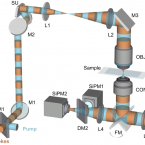
Abstract:
One of the biggest challenges in microbiome research in environmental and medical samples is to better understand functional properties of microbial community members at a single-cell level. Single-cell isotope probing has become a key tool for this purpose, but the current detection methods for determination of isotope incorporation into single cells do not allow high-throughput analyses. Here, we report on the development of an imaging-based approach termed stimulated Raman scattering-two-photon fluorescence in situ hybridization (SRS-FISH) for high-throughput metabolism and identity analyses of microbial communities with single-cell resolution. SRS-FISH offers an imaging speed of 10 to 100 ms per cell, which is two to three orders of magnitude faster than achievable by state-of-the-art methods. Using this technique, we delineated metabolic responses of 30,000 individual cells to various mucosal sugars in the human gut microbiome via incorporation of deuterium from heavy water as an activity marker. Application of SRS-FISH to investigate the utilization of host-derived nutrients by two major human gut microbiome taxa revealed that response to mucosal sugars tends to be dominated by Bacteroidales, with an unexpected finding that Clostridia can outperform Bacteroidales at foraging fucose. With high sensitivity and speed, SRS-FISH will enable researchers to probe the fine-scale temporal, spatial, and individual activity patterns of microbial cells in complex communities with unprecedented detail.
Targeting Gut Bacteria Using Inulin-Conjugated Mesoporous Silica Nanoparticles
2022 - Adv Mater Interfaces, 9: 202102558
Abstract:
To facilitate the creation of novel nanocarrier systems targeting the intestinal microbiome, inulin-conjugated mesoporous silica nanoparticles (MSNs) are described herein for the first time. Surface functionalization is achieved on either hydrophilic or hydrophobic mesoporous nanoparticles using different conjugation methods. The targeting performance of the resulting materials is assessed and compared upon incubation with human stool. It appears that amide formation is the most favorable coupling method on hydrophilic MSNs to achieve the desired bioconjugate. Remarkably, high affinity of gut bacteria to the conjugated particles can be obtained, paving the way to novel targeted drug delivery systems.



